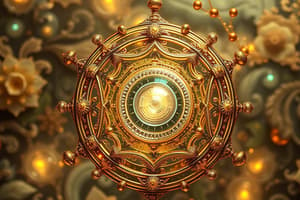Podcast
Questions and Answers
What does the principal quantum number (n) indicate?
What does the principal quantum number (n) indicate?
- The distance from the nucleus (correct)
- The orientation of the orbital in a magnetic field
- The turning direction of an electron
- The shape of the orbitals around the nucleus
Which value can the azimuthal quantum number (L) take for n=3?
Which value can the azimuthal quantum number (L) take for n=3?
- 1, 2
- 0, 1, 2 (correct)
- 1, 2, 3, 4
- 0, 1, 2, 3
What is the range of values for the magnetic quantum number (m) when L=2?
What is the range of values for the magnetic quantum number (m) when L=2?
- 0, 1, 2
- -2, -1, 0, 1, 2 (correct)
- -1, 0, 1
- -3, -2, -1, 0, 1, 2, 3
What does the spin quantum number (ms) describe?
What does the spin quantum number (ms) describe?
Which of the following statements about the principal quantum number (n) is correct?
Which of the following statements about the principal quantum number (n) is correct?
What does the Heisenberg Uncertainty Principle state about the position and momentum of a particle?
What does the Heisenberg Uncertainty Principle state about the position and momentum of a particle?
Which of the following statements best describes the debate between Einstein and Bohr?
Which of the following statements best describes the debate between Einstein and Bohr?
What is one of the key principles of quantum computers regarding electrons?
What is one of the key principles of quantum computers regarding electrons?
What phenomenon allows two entangled electrons to communicate independent of distance?
What phenomenon allows two entangled electrons to communicate independent of distance?
How did the Solvay Conferences contribute to the understanding of quantum mechanics?
How did the Solvay Conferences contribute to the understanding of quantum mechanics?
Which set of quantum numbers is NOT unique for an electron?
Which set of quantum numbers is NOT unique for an electron?
What aspect of quantum mechanics was particularly challenging for Einstein to accept?
What aspect of quantum mechanics was particularly challenging for Einstein to accept?
What does the term 'superposition' refer to in the context of quantum computing?
What does the term 'superposition' refer to in the context of quantum computing?
What are the quantum numbers for the 11th electron of sodium (Na)?
What are the quantum numbers for the 11th electron of sodium (Na)?
Which of the following sets of quantum numbers describes the 9th electron of sodium (Na)?
Which of the following sets of quantum numbers describes the 9th electron of sodium (Na)?
What are the quantum numbers for the 26th electron of iron (Fe)?
What are the quantum numbers for the 26th electron of iron (Fe)?
For the 33rd electron of bromine (Br), which set of quantum numbers is correct?
For the 33rd electron of bromine (Br), which set of quantum numbers is correct?
Which quantum number indicates the shape of the orbital for the 2nd electron in the 3p subshell of sodium (Na)?
Which quantum number indicates the shape of the orbital for the 2nd electron in the 3p subshell of sodium (Na)?
What is the value of ms for the 1st electron in the 1s orbital of sodium (Na)?
What is the value of ms for the 1st electron in the 1s orbital of sodium (Na)?
What are the quantum numbers for the 2nd electron in the 2p orbital of sodium (Na)?
What are the quantum numbers for the 2nd electron in the 2p orbital of sodium (Na)?
Which option correctly identifies the azimuthal quantum number (l) for the 3d subshell in iron (Fe)?
Which option correctly identifies the azimuthal quantum number (l) for the 3d subshell in iron (Fe)?
For the 2nd electron in 4s of iron (Fe), which quantum number (ms) would be most appropriate?
For the 2nd electron in 4s of iron (Fe), which quantum number (ms) would be most appropriate?
What would be the values of n and l for the first electron in the 4p subshell of bromine (Br)?
What would be the values of n and l for the first electron in the 4p subshell of bromine (Br)?
Flashcards
Heisenberg Uncertainty Principle
Heisenberg Uncertainty Principle
A fundamental principle in quantum mechanics stating that it is impossible to simultaneously know both the exact position and momentum of a particle with certainty.
Radial Probability Distribution
Radial Probability Distribution
A mathematical description of the probability of finding an electron at a particular point in space around an atom. It can be visualized as a three-dimensional region where there is a high likelihood of finding the electron.
Quantum Numbers
Quantum Numbers
A set of four numbers that describe the state of an electron in an atom. They define the electron's energy level, shape of its orbital, orientation in space, and spin.
Superposition of Electrons
Superposition of Electrons
Signup and view all the flashcards
Entanglement
Entanglement
Signup and view all the flashcards
Quantum Computers
Quantum Computers
Signup and view all the flashcards
God Doesn't Play Dice
God Doesn't Play Dice
Signup and view all the flashcards
Solvay Conferences
Solvay Conferences
Signup and view all the flashcards
Principal Quantum Number (n)
Principal Quantum Number (n)
Signup and view all the flashcards
Azimuthal Quantum Number (L)
Azimuthal Quantum Number (L)
Signup and view all the flashcards
Magnetic Quantum Number (mL)
Magnetic Quantum Number (mL)
Signup and view all the flashcards
Spin Quantum Number (mS)
Spin Quantum Number (mS)
Signup and view all the flashcards
Quantum Numbers - A Summary
Quantum Numbers - A Summary
Signup and view all the flashcards
What does the principal quantum number (n) represent?
What does the principal quantum number (n) represent?
Signup and view all the flashcards
What does the azimuthal quantum number (l) tell us?
What does the azimuthal quantum number (l) tell us?
Signup and view all the flashcards
What does the magnetic quantum number (ml) tell us?
What does the magnetic quantum number (ml) tell us?
Signup and view all the flashcards
What does the spin quantum number (ms) tell us?
What does the spin quantum number (ms) tell us?
Signup and view all the flashcards
How can you determine the number of electrons in an atom?
How can you determine the number of electrons in an atom?
Signup and view all the flashcards
What is the electron configuration of sodium (Na)?
What is the electron configuration of sodium (Na)?
Signup and view all the flashcards
What are the quantum numbers of the 11th electron of sodium (Na)?
What are the quantum numbers of the 11th electron of sodium (Na)?
Signup and view all the flashcards
What are the quantum numbers of the 9th electron of sodium (Na)?
What are the quantum numbers of the 9th electron of sodium (Na)?
Signup and view all the flashcards
What are the quantum numbers of the 26th electron of iron (Fe)?
What are the quantum numbers of the 26th electron of iron (Fe)?
Signup and view all the flashcards
What are the quantum numbers of the 33rd electron of bromine (Br)?
What are the quantum numbers of the 33rd electron of bromine (Br)?
Signup and view all the flashcards
Study Notes
Heisenberg Uncertainty Principle
- It is impossible to know simultaneously both the position and momentum (mass × velocity) of a particle with certainty.
Electron Probability in the H Atom Ground State
- Electron probability distributions illustrate the likelihood of finding an electron at different distances from the nucleus.
- Figures (A, B, C, D, E) graphically represent the probability of electron location.
A Radial Probability Distribution of Apples
- A visual analogy uses apples distributed around a tree trunk to depict the probability of finding an electron at various distances from the nucleus. The distribution follows a bell curve shape.
4 Quantum Numbers
- Each electron has a unique set of four quantum numbers (n, l, ml, ms).
- Quantum chemistry relies on probability calculations.
- According to calculations, two or more things can be found in the same place, or one thing in two places simultaneously, but the probabilities are very low.
The Bohr-Einstein Debates
- Quantum mechanics describes properties of particles, such as position and momentum, which cannot be precisely determined simultaneously.
- This uncertainty was a challenging concept for some physicists.
- Einstein believed the universe operated in a deterministic manner and that chance did not play a role.
- The Solvay Conferences in Brussels (1927) highlighted this debate, with Einstein challenging the completeness of quantum mechanics through thought experiments.
- Bohr successfully countered Einstein's arguments.
Quantum Computers
- Two important principles govern quantum computers:
- Superposition: Electrons can exist in both low and high energy states (0 and 1) simultaneously.
- Entanglement: Two entangled electrons interact regardless of distance, potentially enabling faster communication than the speed of light.
Quantum Numbers - 1
- Principal quantum number (n): Represents the electron energy shell and is related to the approximate distance from the atom's nucleus.
- Higher "n" values relate to greater electron energy levels.
Quantum Numbers - 2
- Azimuthal quantum number (l): Defines different energy sublevels within a main energy level (n).
- It indicates the shape of the electron orbitals (s, p, d, f).
- l values range from 0 to n − 1.
Quantum Numbers - 3
- Magnetic quantum number (ml): Describes the orientation of electron orbitals in a magnetic field.
- ml values range from −l to +l, including 0.
Quantum Numbers - 4
- Spin quantum number (ms): Represents the intrinsic angular momentum (spin) of an electron in an orbital expressed in clockwise or counterclockwise direction
- ms values can only be +1/2 or −1/2.
Four Quantum Numbers of Each Electron of Sodium Atom
- Table details the four quantum numbers (n, l, ml, ms) for each electron in a sodium atom, based on its electron configuration (1s² 2s² 2p⁶ 3s¹).
What are the quantum numbers of nth electron of an atom
- Additional tables show the quantum numbers of specific electrons in atoms (Sodium, Iron, and Bromine), based on their electron configurations. Different electrons in the same atom have different quantum numbers.
Studying That Suits You
Use AI to generate personalized quizzes and flashcards to suit your learning preferences.




